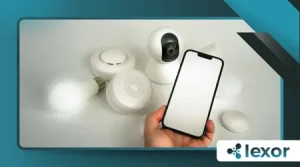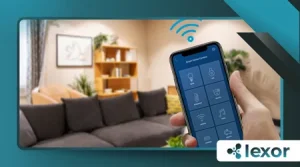How the Matter Protocol Makes Smart Home Devices Finally Play Nice Together

Matter Protocol Makes Smart Home Devices Finally Play Nice: For years, the promise of the smart home felt trapped by digital walled gardens.
We all wanted our devices to work in concert, yet a Philips Hue bulb often refused to sync with a Samsung SmartThings hub, or an Amazon Alexa routine couldn’t fully integrate a Google Nest thermostat.
This technological balkanization was frustrating, expensive, and a major barrier to mass adoption. Now, a seismic shift is underway.
The Matter Protocol Makes Smart Home Devices Finally Play Nice, delivering a universal language that is changing the entire landscape.
This isn’t just an update; it’s the architectural foundation the smart home always deserved.
What is the Matter Protocol and Why Does it Exist?
Matter is an open-source, royalty-free connectivity standard built on the robust Internet Protocol (IP).
It is essentially the unified “lingua franca” for smart devices, allowing them to communicate locally with each other, regardless of brand or ecosystem.
It emerged from a collaborative effort by the Connectivity Standards Alliance (CSA), which includes tech titans like Apple, Google, Amazon, and Samsung.
Its existence is a direct response to consumer frustration over incompatibility.
Why should purchasing a new smart lock require checking a compatibility matrix against your smart speaker?
Read more: Bitcoin vs Ethereum vs Stablecoins: Key Differences Explained
Matter eliminates this dependency, certifying devices to a single, shared technical specification.
How Does the Matter Protocol Achieve True Interoperability?

Matter doesn’t replace Wi-Fi or Thread; it rides atop them as an application layer.
By using established IP-based networking technologies, it creates a secure, local communication fabric among all certified devices.
This local control enhances responsiveness and reliability, eliminating dependence on the cloud for every command.
++Voice, Gesture & Spatial Commands: The Next Frontier for Smart Homes
Imagine the smart home as a bustling international airport; before Matter, every airline (brand) had its own unique passport and border control (proprietary protocol).
Matter is like adopting a single, universally accepted travel document, enabling passengers (data) to move freely between all gates (ecosystems).
This analogy perfectly captures the seamless, friction-free movement of control signals.
Why the Matter Protocol Makes Smart Home Devices Finally Play Nice is the New Reality?
The core value proposition is freedom of choice and true future-proofing.
++Smart Lights Explained: How They Work and Why You Need Them
Consumers are no longer locked into one manufacturer’s ecosystem merely for the sake of functionality.
You can mix and match the best security camera, the most energy-efficient thermostat, and the preferred lighting system, all operating together flawlessly.
This interoperability accelerates innovation by lowering the barrier to entry for smaller manufacturers.
They can focus purely on creating superior hardware and unique features, confident their products will integrate with the existing major platforms.
++Here’s What the ‘Matter’ Smart Home Standard Is All About
This is a crucial win for both market competition and consumer benefit.
Which are the Most Significant Benefits for Users and the Industry?
The advantages ripple out across the entire user experience.
First, setup is dramatically simplified, often requiring just a single QR code scan to connect to any Matter controller, be it an Apple HomePod, a Google Nest Hub, or an Amazon Echo.
Second, true multi-admin support allows your home to be simultaneously controlled by multiple ecosystems, enabling every family member to use their preferred app or voice assistant.
| Feature | Pre-Matter Smart Home | Post-Matter Smart Home (2025) |
| Interoperability | Limited; brand-specific apps | Universal; works across all Matter controllers |
| Setup Process | Complex; multi-step, app-dependent | Simplified; single QR code commissioning |
| Local Control | Often Cloud-dependent and slow | Standard; fast, reliable local network communication |
| Vendor Lock-in | High; necessary for full feature set | Low; mix and match devices freely |
This structural shift also significantly bolsters security, another benefit that cannot be overstated. All Matter devices are required to use secure, certified components and encryption for all communication.
How Does Matter Enhance Smart Home Security and Reliability?
Security in the smart home is paramount, and Matter addresses this by embedding robust, standardized cryptography right into the protocol.
All communication within the Matter “Fabric”—the local network of devices—is securely encrypted and authenticated.
For example, in the current iteration (Matter 1.4.2, released in August 2025), there have been major improvements to transport reliability and PSA-based crypto, ensuring that unauthorized devices cannot join or eavesdrop on your network.
What Does the Current Market Adoption and Future Look Like?
The initial launch established Matter in key product categories like lighting, plugs, and switches.
By late 2025, adoption is expanding rapidly into areas like energy management, with support added for solar panels, batteries, and heat pumps (Matter 1.4).
According to a recent industry report, 78% of first-time home buyers in 2025 now consider smart home readiness and certified interoperability a major purchase factor.
This statistic highlights the immediate market demand for the seamless experience that Matter delivers.
The next phases promise cameras, video doorbells, and more complex appliances, solidifying Matter’s role as the definitive standard.
This momentum confirms that the Matter Protocol Makes Smart Home Devices Finally Play Nice not just as a promise, but as a practical reality across product categories.
Conclusion: The Era of Seamless Smart Homes is Here
The journey to the truly intelligent home has been long, marked by proprietary roadblocks and consumer compromise.
Matter represents a pivotal moment, a necessary coalition to dismantle those barriers. It restores faith in the core promise of the smart home: automation that just works.
The future is one where you buy the best device for the job, secure in the knowledge it will seamlessly join your digital ecosystem.
With the wide-ranging support and continuous updates seen in 2025, the Matter Protocol Makes Smart Home Devices Finally Play Nice is the most accurate summary of the state of connected living.
The era of the seamless smart home is finally upon us.
Frequently Asked Questions
Is Matter a replacement for my current smart home hub?
Matter is a communication standard, not a physical hub. It requires a Matter “Controller,” which is often a modern smart speaker (like an Amazon Echo or Google Nest Hub), a dedicated hub (like a SmartThings Hub), or an Apple TV/HomePod. These controllers act as the central brain to set up and manage your Matter devices locally.
Do I need to buy new devices to use Matter?
Not necessarily. Many manufacturers have released software updates for existing “bridge” devices (like older smart lighting hubs) or compatible smart speakers, allowing them to act as Matter controllers for your older, non-Matter devices. However, new devices with the official Matter logo are certified to work natively with the protocol, ensuring the most seamless experience.
What are the main networking technologies Matter uses?
Matter runs over existing, IP-based networks: Wi-Fi for high-bandwidth devices like cameras (in future iterations) and large controllers, and Thread for low-power, mesh-networked devices like sensors and lights. It also uses Bluetooth Low Energy (BLE) for the initial device setup and commissioning process.
